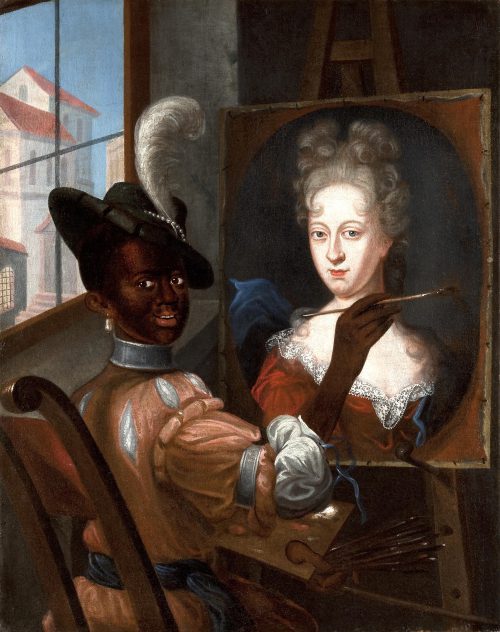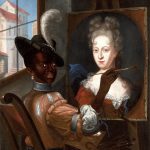9897 BLACK ARTIST COMPLETING A PORTRAIT OF MARIA ANNA OF AUSTRIA, QUEEN OF PORTUGAL (1683-1754) Possibly Brazilian School. First Half Of The Eighteenth Century. Measurements: Height: 41″ (104 cm) Width: 32 1/2″ (81.5 cm)

Research
Oil on canvas.
Provenance:
Michael Hogg Gallery, Knightsbridge, London 1967.
Philadelphia Private Collection.
In this most unusual painting dating from the beginning of the 18th century, an elaborately dressed black artist paints a portrait of Maria Anna of Austria, Queen of Portugal (1683-1754), in a small interior with a cityscape beyond. There is an unquestionable likeness of the sitter with an 18th century portrait of this queen by Pompeo Batoni in the collection of the Ajuda National Palace (figure 1), and a second early-18th century depiction by an unknown artist (figure 2).
Although the black artist of the present painting could, at first glance, be considered of feminine appearance, it is more likely a male figure. As the scholar Sheldon Cheek explains,1 the artist wears a pearl earring, which, while not exclusively worn by males, was more commonly seen on black male slaves than females in the 17th and 18th centuries (figure 3). The metal collar would be especially indicative of a male slave, as would the “shackle,” which the present painter wears on his arm; according to Sheldon Cheek neither of these would typically be worn by female slaves.
The present painting belongs to a very small body of works in which black subjects are depicted in ‘scholarly’ and artistic roles, as distinct from paintings where they are shown in a subservient manner, offering food or presenting a garment, and thus acting as emblems of their owner’s wealth and sophisticated taste. The representation of blacks following intellectual pursuits is very rare; one example is the portrait of Francis Williams, the Negro Scholar of Jamaica, circa 1740, in the Victoria and Albert Museum. The son of wealthy former slaves, Williams enjoyed a European lifestyle and the opportunity to pursue poetry and mathematics. In that portrait, Williams is depicted in his study with the Jamaican city of Spanish Town in the distance. Another painting includes the African-born architect and sculptor, Mestre Valentim, presenting plans for the reconstruction of the Retreat of Nossa Senhora do Parto in Rio de Janeiro, Brazil, by Joâo Francisco Muzzi, circa 1789, in the collection of Museus Castro Mayo.
The present painting is even more unusual in that it is likely a self-portrait by an enslaved black artist, representing himself while painting Portugal’s Queen. The pose of the artist closely resembles the self-portrait by Judith Leyster circa 1630, today in the National Gallery of Art, Washington DC (figure 4). Leyster adopts a relaxed position, leaning back in her chair, her right hand raised with a brush, the left at her lap holding her palette and collection of other brushes. Leyster is dressed in formal attire; while the clothing would not be suitable for an artist at work, it does convey that the she is not merely a painter, but a member of the liberal arts with social position. She “manages to assert, in the most offhanded way, that she has mastered a profession traditionally viewed as a masculine domain.”2 With a similarly confident smile, it would appear that the black artist in the present painting is also acknowledging the unusual achievement for his station. In a further most interesting coincidence, the picture of the violin player that Leyster paints was not the initial subject; infrared reflectography has revealed that a portrait of a woman appears underneath (figure 5). Leyster’s entire body of work was not known to be her own, but instead thought to belong to Frans Haals up until the late 19th century. As the assumed work of an old master, it is possible that engravings of the painting traveled to Brazil and served as the inspiration for the present composition.
A further interesting insight into the present picture is afforded by observing the garments of painter and sitter. The slashed shoulders and scrolled upper sleeve of the painter’s coat are typical of 17th century; the cavalier’s hat decorated with feather, though not necessarily with pearl necklace, was also worn in the 17th century. While the painter’s outfit can, therefore, be dated approximately 80 – 100 years prior to the period of the painting itself, the dress and hairstyle of Queen Maria Anna are contemporary to the date of the painting. The chair, of which only a part of the back is visible, fits within the tradition of the Frailero, distinguished by its back formed of two uprights connected by a panel of leather attached to the front with decorative boss head nails; alternatively it could be what is now known as a “Renaissance Folding Chair,” (figure 6) similarly formed of upright seat rails connected by a leather panel, which would have suited a painter’s need for mobility.
The origin of the present painting is as yet uncertain, however, several leading art scholars have pointed to a likely Brazilian origin on stylistic grounds. Furthermore, according to the specialist Spanish and Colonial art advisor D. Bentley Angliss, short tiled roofs of this lively and distinctive reddish-pink color that can be seen through the window behind the artist are consistent with colonial Brazil, which was under Portuguese rule until 1822. Examples of very related architecture can be found in eighteenth century depictions of Rio de Janeiro such as the roof construction and color in two 18th-century paintings, “Fire at the Retreat of Nossa Senhora do Parto” and “Reconstruction of the Retreat of Nossa Senhora do Parto,” by João Francisco Muzzi (mentioned earlier) (figure 7), or depictions of the area surrounding the Paço Imperial (figure 8). The architecture is also reminiscent of that found, for example, in the Brazilian northeastern coastal city of Ceará, settled as a fief of the Portuguese crown whose economy in the 18th century centered on sugar plantations worked by black slaves, and later the mining towns of Minas Gerais, such as Ouro Preto, where slave labor was employed during the gold rush and whose magnificent Baroque architecture is well-preserved even today.
The slave population in Brazil was the largest in the world; the importation of mainly African slaves spanned four centuries. In the 1600s, when native Americans were no longer considered a viable labor force due to large numbers of deaths from abuse and disease, the Portuguese began importing black Africans to support their sugarcane ventures, and from the 1690s onwards, the diamond industry. Although slavery was abolished in Portugal in 1761, it was not until 1881 that Brazil enacted it’s final abolition, the last country in the Western World to do so. Despite this prolonged injustice, it appears that some slaves in Brazil experienced a less severe conditions than those in other parts of the world. Religion played a large role in the treatment of slaves there. Christianization was required and groups of slaves were baptized en masse, and slaves that worked on plantations owned by religious orders were given unusually fair treatment. Working conditions and hours varied greatly for different slaves; while plantation and mine workers’ life expectancy was only 7-10 years,3 domestic slaves and their descendents appear to have fared somewhat better. “Many mestizos used their abilities as artists, artisans and musicians to carve a niche for themselves within the dominant white social structure, [and a] large number of mulatto artisans and artists could ascend within the inequitable colonial structure.”4
The present painting immortalizes a slave artist at his work and thus represents an exceedingly rare piece of pictorial evidence of this “relatively benign form of racial integration and social toleration, which enabled individuals of African descent to fulfill the role of ‘artists.’”5
Footnotes
- Cheek, Sheldon. “RE: Painting of a Black Female Artist.” 11 Mar. 2011. E-mail.
- Arthur K. Wheelock Jr., “Judith Leyster/Self-Portrait/c. 1630,” Dutch Paintings of the Seventeenth Century, NGA Online Editions, http://purl.org/nga/collection/artobject/37003 (accessed June 29, 2015).
- Tribe, T. C. “The Mulatto as Artist and Image in Colonial Brazil.” Oxford Art Journal 19.1 (1996): 67-79. p 68.
- Ibid., 70.
- Ibid.

Comments are closed.